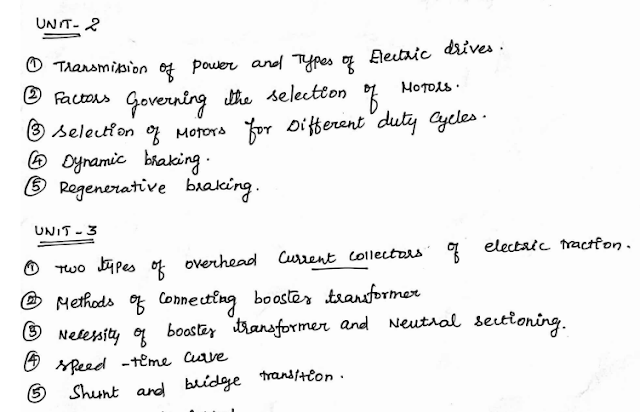D&U BOARD EXAM QUESTION PAPER OCT 2024 , AP 2024, OCT 2023, APR 2023 PDF 👉 Download
D&U OCTOBER 2023 QUESTION PAPER
👇
Click on the links in New Tab for Download Error
EEE - 4030610- DISTRIBUTION AND UTILIZATION STUDY MATERIALS
D&U 3 MARKS ENGLISH 👇
D&U 3 marks Tamil👇
DU 3 Marks Tamil+Eng 👇🏻
D&U FULL QUESTION BANK 👇
NSK UPDATES- TAMILAN ULAGAM
4030610 –
DISTRIBUTION AND UTILIZATION FULL QUESTION BANK – QUESTION BANK FOR APRIL 2024 BOARD EXAM
14 MARKS QUESTION BANK
UNIT 1
1. COMPARE CAST OF CONDUCTOR IN 3 PHASE FOUR WIRE AND TWO WIRE DC SYSTEM
2. TYPES OF SUBSTATION
3. PRIMARY AND SECONDARY DISTRIBUTION SYSTEM
4. TYPES OF BUS ARRANGEMENT
5. DOUBLE BUS BAR ARRANGEMENT
UNIT 2
1. FACTORS GOVERNING THE SELECTION OF MOTORS
2. LOAD DUTY CYCLE – MOTOR SELECTION
3. APPLICATION OF REGENERATIVE BRAKING IN DC SHUNT AND SERIES MOTOR
4. DIFFERENT CURRENT COLLECTORS USED IN ELECTRIC TRACTION
UNIT 3
1. MAGNETIC LEVITATION IN ELECTRIC TRACTION
2. CREST SPEED USING TRAPIZOIDAL SPEED TIME CURVE
3. MULTIPLE UNIT CONTROL
4. BOOSTER TRANSFORMER
UNIT 4
1. SODIUM VAPOUR LAMP
2. TWO LAWS OF ILLUMINATION
3. INDUCTION LAMP
4. HIGH PRESSURE VAPOUR LAMP
UNIT 5
1. LASER AND ELECTRON BEEM WELDING
2. DIRECT CORE TYPE INDUCTION
3. DIRECT AND INDIRECT ARC FURNACES
4. DIELECTRIC HEATING
D AND U IMPORTANT QUESTIONS
sem 6 DEEE
Distribution & Utilisation
Important Question
Unit 1
1. What are the advantages and disadvantages of outdoor succession (1.05)
2 .Diagrammatically represent the layout of a typical 110 KV / 11 KV substation with all details (1.09 )
3. Explain the different equipments used in a substation (1.10- 1.14)
4. Draw and explain typical double bus bar, single bus bar, ring bus bar arrangement and enumerate its advantages( 1.18 to 1.20)
5. Compare the cost of conductor in AC three phase 3 wire to DC two wire on general assumption( 1.33)
Unit 2
6. Explain different types of drives used in industrial load( 2.05-2.07)
7. Explain load duty cycle and how motor is selected from a given duty cycle (2.15-2.19)
8. Choose the motor suitable for the following application. give reason for your choice .
i) Paper mail (2.19)
ii) Cement mill(2. 20)
iii) Belt conveyor( 2.22) iv)Centrifugal pump (2.23).
v) Lift and hoist (2.22)
vi) reciprocating pump (2.23 )
vii) Machine tools( 2.21) 9. Explain dynamic breaking is applied for DC shunt motor and 3 phase induction motor (2.31)
10. Explain the method of regenerative breaking with DC motor and AC motor(2.34-2.35)
Unit 3
11. Explain different current collectors used in electric traction (3.06-3.08)
12. What is the function of booster Transformer in traction?
Explain i) Rail connected booster Transformer
ii) Booster Transformer with return feeder (3.09- 3.12)
13 Drives from basic principles for crest speed using trapesoidal speed time curve. State all your assumption clearly with relevant units ( 3.19- 3.21)
14. Briefly explain the shunt transistion and Bridge transistion (method of serial parallel connection )(3.33 -3.35) 15. Explain with neat sketch multiple unit control .(3.35 to 3.37)
Unit 4
16. State and prove two laws of illumination (4.09)
17. List the five types of lighting schemes with a brief note on each type (4.24 - 4.28 )
18. Explain with neat sketch the working of sodium vapour lamp.( 4.46)
19. Explain the diagram of a high pressure Mercury vapour lamp (4.48)
20. Explain the operation of induction lamp (4.51- 4.54)
Unit 5
21. Explain the operation of direct Core type induction furnace (5.21) 22. Explain the operation of an Ajaxwyatyot core type furnace (5.22 )
23. Explain different types of Resistance heating (5.04 - 5.06 )
24. Explain various method of high frequency electric heating( 5.08 - 5.13)
25. Direct ARC furnace, indirect ARC furnace (5.18)














No comments:
Post a Comment